Mille-Feuille (Napoleon Pastry) contains two building blocks of classic French Pastry - Puff Pastry (Mille-Feuille - pronounced meel-foy) and Crème Pâtissière or pastry cream for one elegant dessert. While puff pastry can be daunting to make at home, it needn't be. See my post on Pithiviers Made with Blitz Puff Pastry, featuring a quicker way to make it.
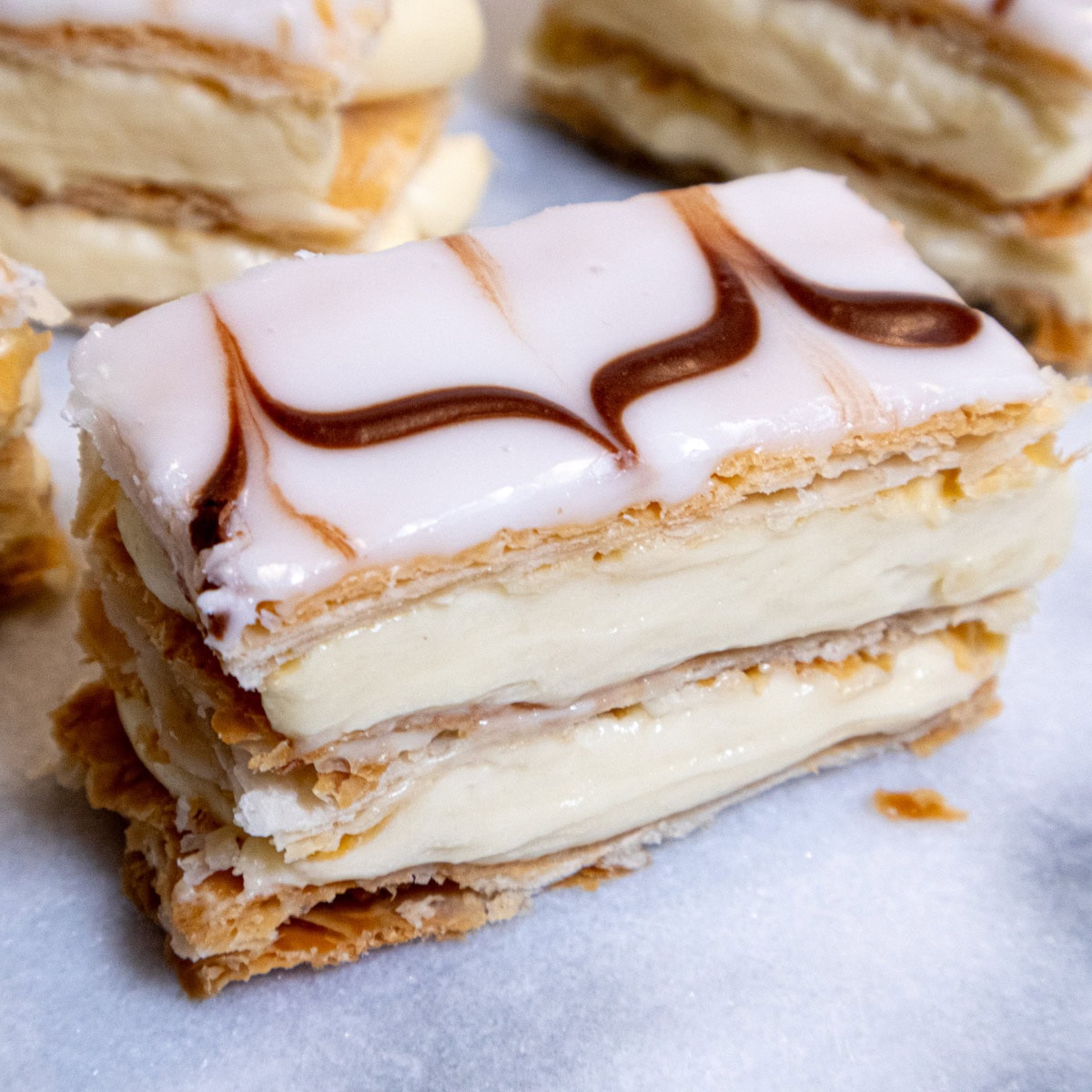
While this Mille-Feuille recipe (Napoleon Pastry) may look daunting, you absolutely can do this and I'll show you how. To make things easier I use an all butter purchased puff pastry which makes everything go much easier and faster. Puff pastry is baked until it is crisp and then sandwiched with a creamy Diplomat Cream which is simply lightened pastry cream.
To make this more inviting, the pastry can be frozen completely with the mock fondant top in place.
However, to speed things along without sacrificing quality, I chose a premade all butter puff pastry for this post. The key word here is all butter. There are other versions made with special shortenings that ensure a high puff but the shortening used coats the mouth and is unpleasant ruining your beautiful Napolean.
I used Dufour All Butter Puff Pastry which I found at Whole Foods. The single sheet just needs a few turns of the rolling pin to make it the perfect size for this particular method. Alternatively, feel free to make your own.
My pastry cream is a snap to make and can be made months ahead and stored in the freezer, something that is impossible with cornstarch based pastry cream. It can also be stored in the refrigerator a couple of days ahead.
A couple of other posts about puff pastry include: A Discussion of Laminated Doughs, Sunny Side Up Apricot Pastries, and Chocolate Marshmallow Cream Horns.
Jump to:
What is Mille-Feuille?
Mille-Feuille is a French pastry made from puff pastry and means a thousand leaves due to many layers when it is baked. The butter which is incorporated between many layers of dough (1000 leaves) creates steam when it is baked and causes the dough to rise to great heights, hence the name puff pastry.
The photos below will guide you through the process and when finished it will impress even the most discerning dessert lovers.
How My Version Differs
Long ago when I wrote my first book, The New Pastry Cook, I featured a chapter on puff pastry. In the book I had a revolutionary way of making the puff pastry, much as I do for my Croissants. It took the time down from days to hours. I still use it today.
How to Stop the Pastry from Shrinking
When it came to Mille-Feuille (I called it Napoleons in the book) I found a way to stop the the pastry from shrinking as it normally does when baked. I simply hung it upside down over the back of a jelly roll pan and weighted it down. It seems everyone writing about Mille-Feuille is using the weighting down part but the upside down part is just as helpful. See the photos below.
Docking the Pastry
It is important to dock the pastry (docking is the technical term bakers use for making small holes in the pastry) This prevents the pastry from rising too much by letting the steam escape or bubbling up and it also helps keep it flat which is important for this recipe. This is easily done at home with a fork.
Recipe Ingredients
Pastry Cream
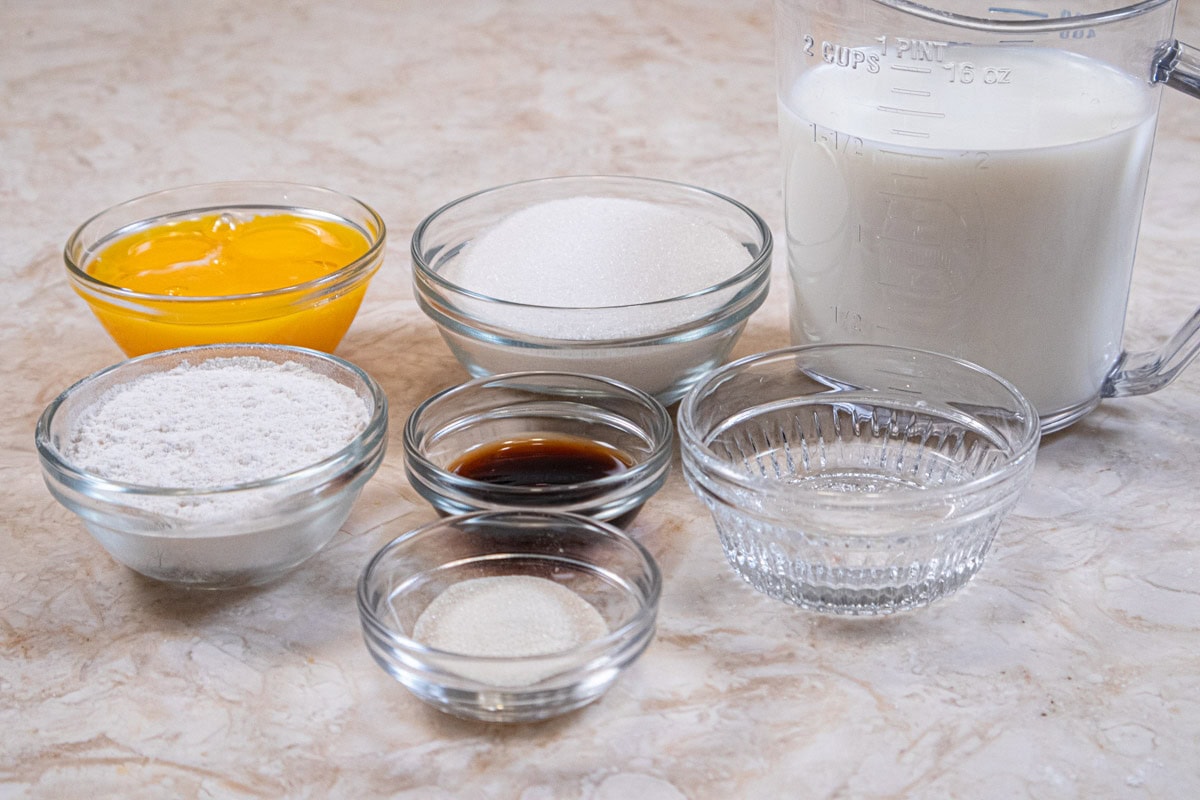
Ingredients for the Pastry Cream include: Egg yolks, granulated sugar, milk, all-purpose flour, pure vanilla extract, water and gelatin.
Mille-Feuille
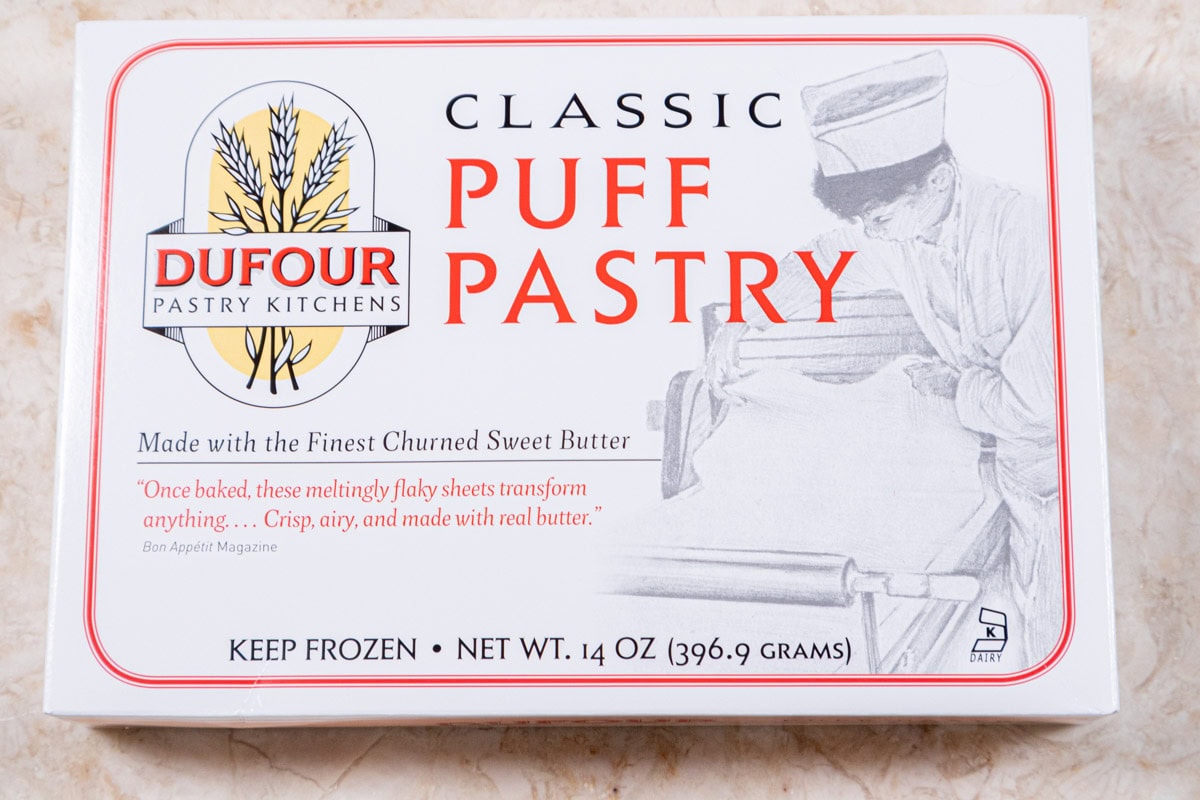
Dufour all Butter Puff Pastry
Mock Fondant
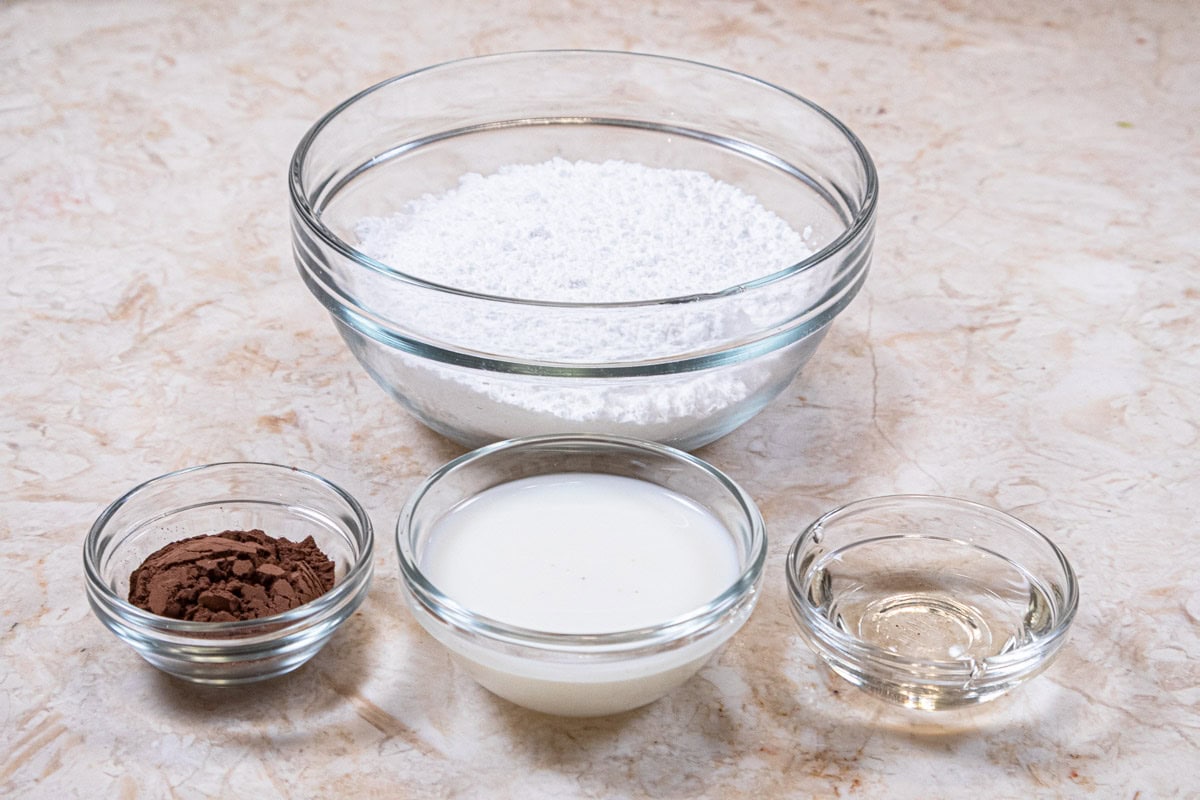
Ingredients for the Mock Fondant include powdered sugar, cocoa powder, milk and corn syrup.
Key Ingredients
- While I often recommend using McCormicks Imitation Vanilla for some recipes, this is one recipe where I recommend pure vanilla. If you have Tahitian vanilla, it lends an exquistite flavor to the pastry cream.
- All Butter Puff pastry is a must for this recipe. Those using other shortenings are not comparible.
- The Mock fondant is a thick powdered sugar glaze that is made with milk and a bit of corn syrup, both of which ensure a shiny finish that will not turn dull as will water. It is the traditional finish to Mille-Feuille and easy to make. The chocolate chevron design is made by adding cocoa to a small amount of the mock fondant.
Be sure to see the recipe card below for t he full ingredients & instructions.
Step by Step Instructions
Pastry Cream
Please see my post on Pastry Cream Filling for the full set of photographs.
Mille-Feuille
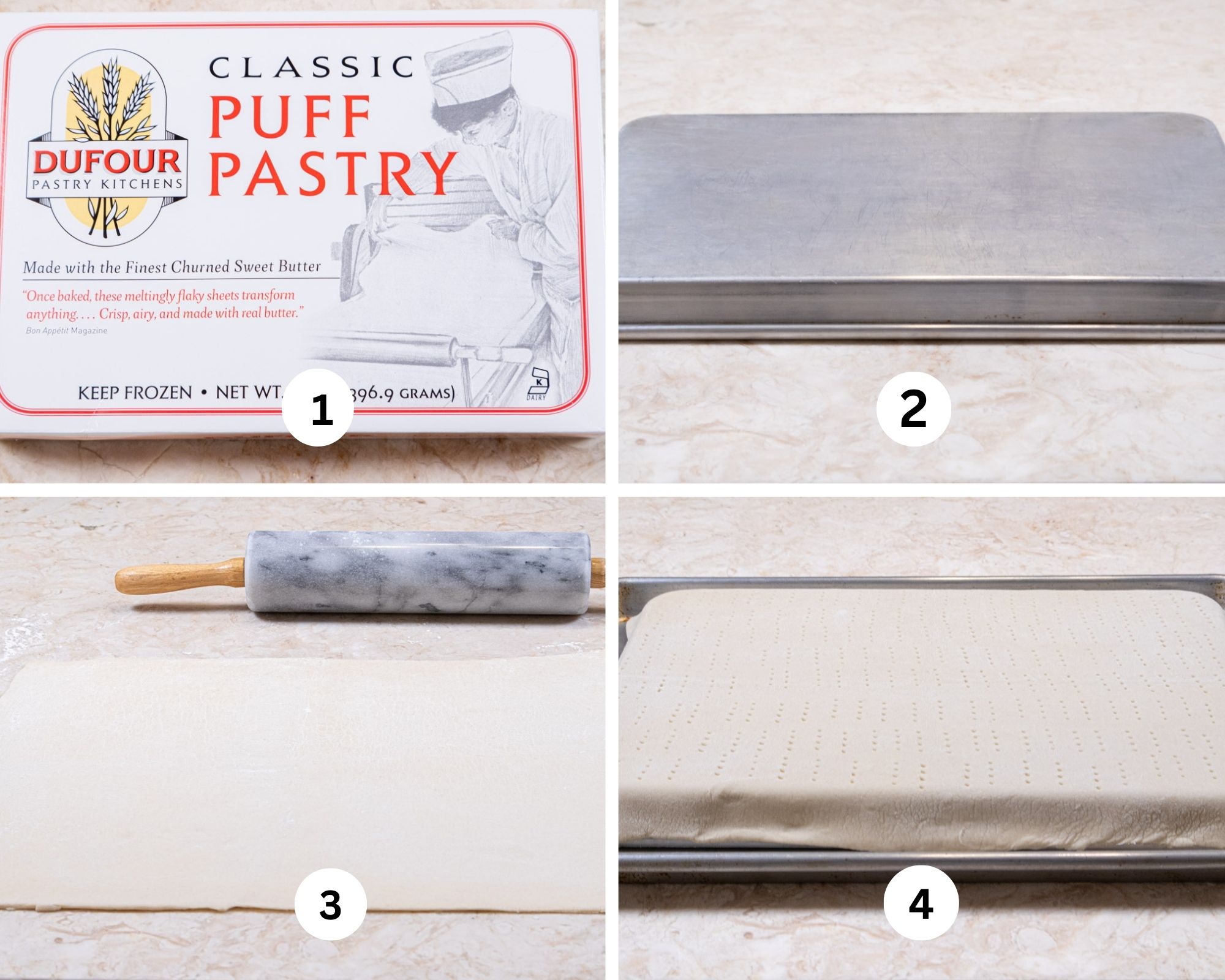
Step 1. The pastry comes frozen and needs to be thawed. Dufour suggests 3 hours in the refrigerator. I usually put it in the night before but it is a bit soft and care has to be taken to unfold it. Step 2. Turn a jelly roll pan (10x15 inches) upside down. Alternatively place the rolled out dough in a half sheet pan and continue with the same directions. Step 3. Roll the pastry into an 11 x 16 inch rectangle. Step 4. Place it over the back of the jelly roll pan with about 1" hanging down the sides. Dock the pastry with a fork all up and down the pastry about an inch or two apart. Freeze until the pastry is hard.
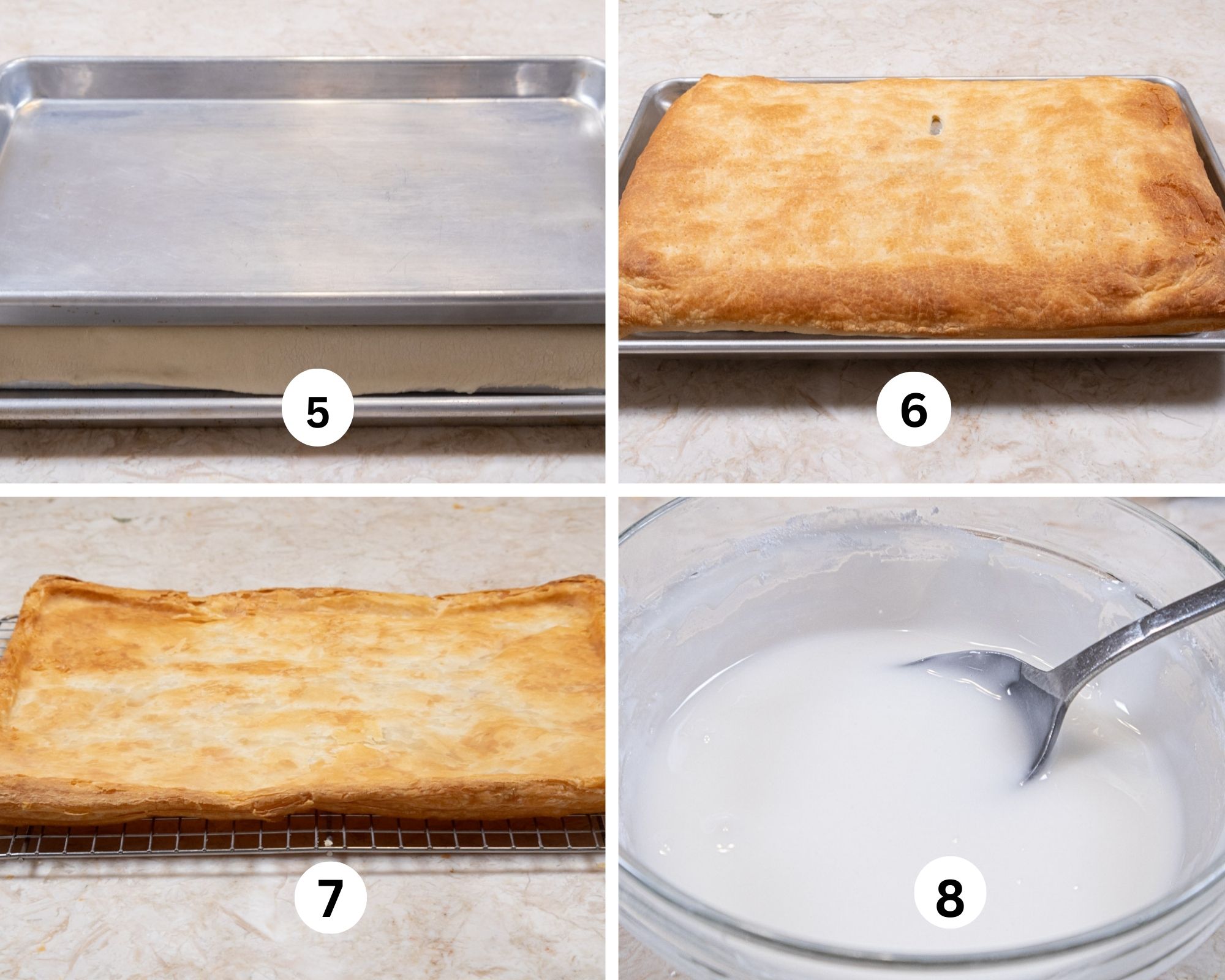
Step 5. Place a sheet of parchment paper on top of the pastry or spray the bottom of the top jelly roll pan with a non-stick baking release and place it on top of the paper or pastry. Step 6. Bake on the lowest rung of the oven as directed. Step 7. When the pastry comes from the oven, carefully turn it over and bake for 5 to 8 minutes more to bake that side. Cool on a wire rack. With a serrated knife, trim the overhanging pastry off. Cut the pastry into 3 equal pieces legnthwise (about 3" each). Step 8. Combine the ingredients for the Mock Fondant adding additional milk if necessary but keep it thick. It should flow but not run down the sides.
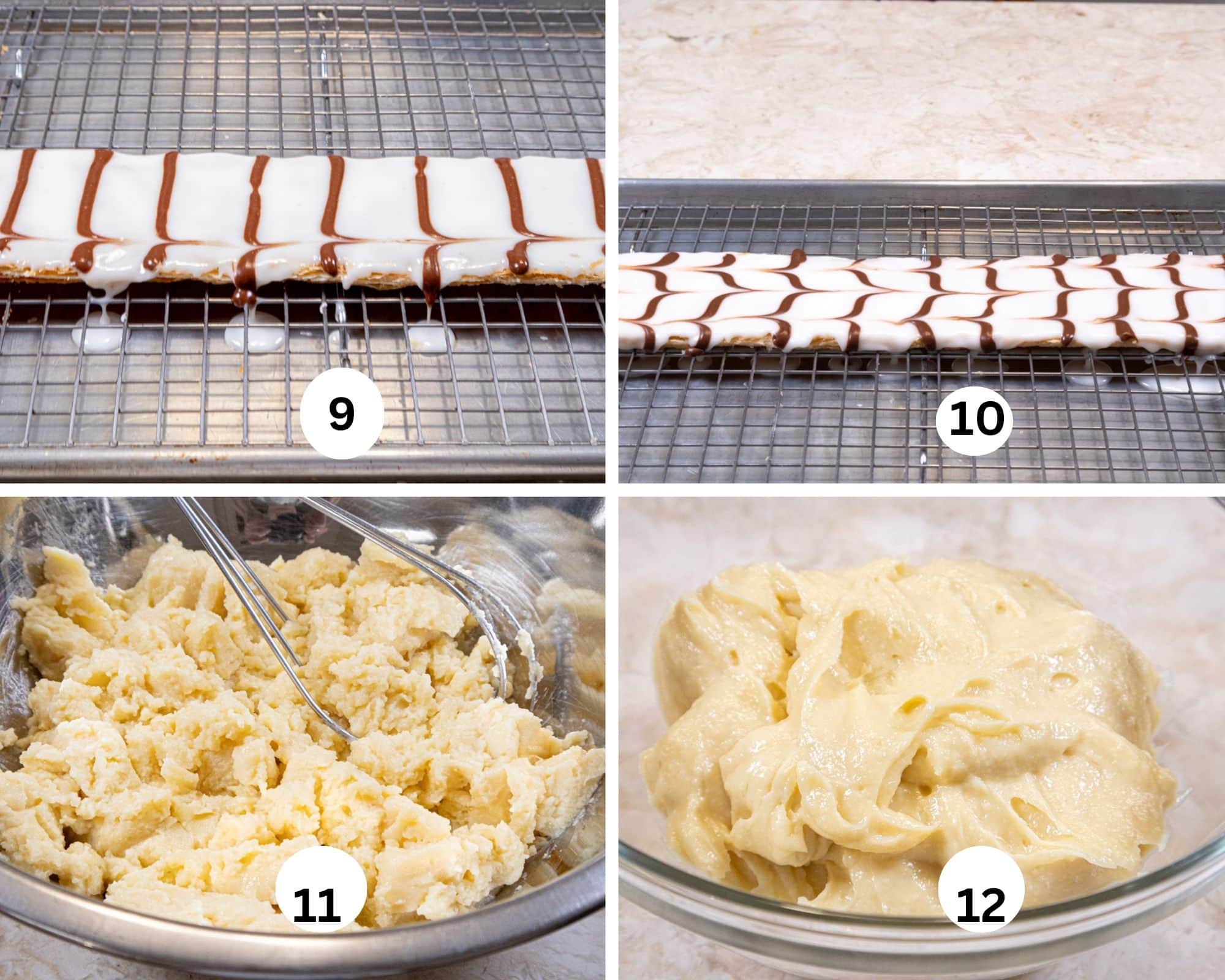
Step 9. Place one of the puff pastry layers on a rack in a sheet pan or over parchment or waxed paper. Reserving about 3 tablespoons of the fondant, spread the remainder over the pastry with an offset spatula, covering it completely as evenly as possible. Immediately, before the fondant sets, add 1 tablespoon of cocoa powder to the reserved fondant, stirring it in well. You will probably need to thin it to piping consistency with a bit of milk. Place the cocoa fondant in a pastry bag fitted with a small open tip (a # 4 or 5) and pipe straight lines across the fondant about an inch apart. Step 10. Using a toothpick, draw a straight line all the way down the fondant. Move over about an inch and make another straight line up the pastry. Repeat twice more. This will give you the traditional chevron design. Allow the fondant to set up 10 to 15 minutes before continuing. Step 11. Remove the pastry cream from the fridge and break it up with a whisk. Step 12. Whisk it until it is smooth. It will be very thick, just keep whisking.

Step 13. Whip the cream stiffly and fold it into the smoothed out pastry cream to make Diplomat cream. Step 14. Place the pastry cream into a piping bag fitted with a ½" plain tip and pipe half over each of the two remaining strips of pastry. Alternatively, spoon it on. Step 15. Assemble the pastry by placing the filled pastry strips on top of each other and the fondant finished strip on top. Step 16. If the fondant is not firm, let it set up until it is. Chill the pastry. To cut it, use a serrated knife and saw through the pastry layers about 1 ½" apart. Do not cut straight down. The pastry can also be frozen, entirely finished with the fondant. When the fondant is completely set it will be firm all the way through. Place a piece of plastic wrap directly on top and freeze it whole. When it is frozen, wrap it in foil where it can be stored for a month or so. Remove the foil, leaving the plastic wrap on top. Thaw it in the fridge overnight. Remove the plastic wrap and cut when it is cold or partially thawed for the best slices.
A note about serving. This is a plated dessert and should be served with a fork. The filling will squish out when cut but it does that with all mille-feuille.
Recipe FAQS
While vanilla pastry cream is traditional, other flavors of pastry cream can be used as well as fruit topping the pastry cream can be used.
Traditional fondant is made of powdered sugar, water, corn syrup, gelatin and glycerin. It is actually a dough and can be rolled out to cover cakes. Mock Fondant uses powdered sugar, water or milk and corn syrup. It can be used in various thicknesses and poured on. It will dry very firm, almost hard.
Puff pastry is a laminated dough meaning it is rolled out with butter between the layers, which when baked, melt, causing steam which pushes the dough upwards. Puff pastry is folded upon itself many times and if made correctly the math says it has over 1000 layers. In fact, the classic French method results in a pastry with approximately 1,500 layers.
Expert Tips
- This is one place I definitely recommend pure vanilla. If you have Tahitian, it makes the best pastry cream.
- For the best results, roll the pastry to the correct size. It will be thin but that is as it should be.
- Keep the pastry chilled to work with it. Freeze it hard before baking.
- Some recipes add pie weights to the pan weighing down the pastry. I don't find that necessary, especially with purchased all butter puff pastry.
- Be sure to flip the pastry over after the initial baking to make sure the underside is baked. If not, return it to the oven for 5 to 10 minutes to bake it.
- if the Mille-Feuille is refrigerated for several days the pastry will loose some of its crispness but it will still be very good.
- Freezing and thawing seems to retain the crispness.
- The pastry cream will be very stiff after it has been chilled. That is how it should be.
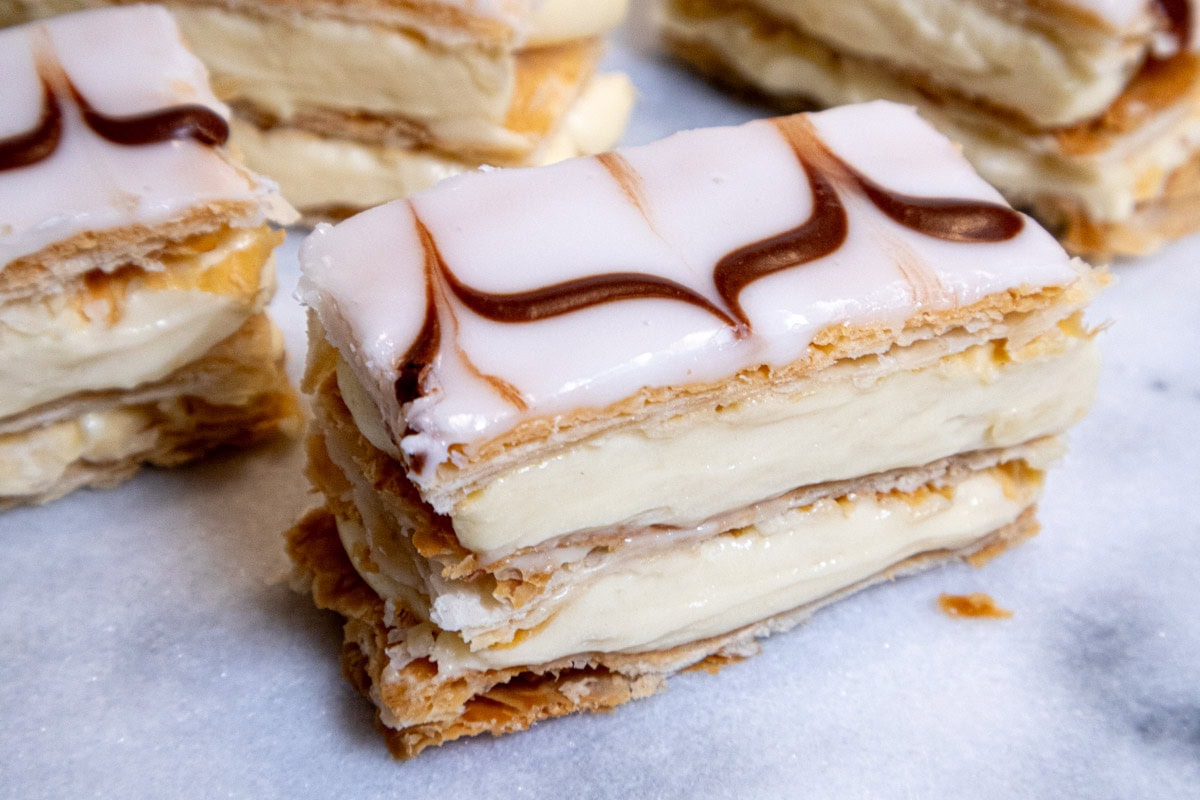
Other French Pastries for You
Love this Mille-Feuille? It would be hugely helpful and so appreciated it if you would take a moment to leave a star rating. Thank you.
Mille-Feuille (Napoleon Pastry)
Equipment
- 2 Jelly Roll Pans (10x15) or 2 half sheet pans
Ingredients
Pastry Cream
- t teaspoon unflavored gelatin
- 1 tablespoon cold water
- 1 ⅓ cups milk
- 4 large egg yolks
- ½ cup granulated sugar (100 grams)
- 3 tablespoons all-purpose flour
- 1 teaspoon vanilla
- ½ cup heavy cream
Mille-Feuille (Napoleon Pastry)
- 1 14 ounce package Dufour All-Butter Puff Pastry
Mock Fondant
- 1 cup powdered sugar (130 grams)
- 3 to 4 tablespoons milk
- 1 tablespoon corn syrup
- 1 tablespoon cocoa
Instructions
Pastry Cream
- Before you start, I encourage you to look at the photos in the post which serve as a guide to make this extraordinary pastry.
- In a very small bowl, add the gelatin to the water, stirring to combine. Set aside.
- In a small saucepan, heat the milk until very hot but not boiling.
- In a medium size bowl, whisk the egg yolks and sugar together. Whisk in the flour followed by the hot milk. Pour the mixture through a fine mesh strainer into a saucepan.
- Place over medium heat and, stirring continuously, bring it to a boil. Cook for 1 minutes, still stirring.
- Remove from the heat, tear the gelatin into pieces and add to the pastry cream. There is no need to liquify them as the hot pastry cream will melt them. Stir them in after they have melted.
- Transfer to a storage container, cover the top with plastic wrap, poke a few holes in it and let it come to room temperature. Place a lid on the container. Store in the refrigerator for 3 or 4 days or freeze for several months. Thaw in the refrigerator overnight to use.
Diplomat Cream or Lightened Pastry Cream
- To make the Diplomat Cream or Lightened Pastry Cream, beat the ½ cup cream until stiff peaks form.
- Remove the pastry cream from the fridge and break it up with a whisk. It will be very firm and that is how it should be. Whisk until smooth. Fold in the whipped cream. This can be made ahead of time and stored in the refrigerator for a day or two before using.
Mille-Feuille (Napoleon Pastry)
- I encourage you to see the photos above to clarify these instructions as they are different from most.
- Thaw the puff pastry as directed. Dufour recommends 3 hours in the refrigerator and it's ready. I usually thaw mine overnight but that can make it softer so care needs to be taken to unwrap it, remove the paper and flatten it out.
- On a lightly floured surface, roll the pastry into a an 11x14 inch rectangle.
- Turn the jelly roll pan upside down and place the puff pastry on it. It should overhang the pan on every side. Alternatively, use two half sheet pans, placing the pastry rolled as called for in the pan. Continue as directed.
- Dock the pastry about every inch or so with the tines of a fork. This is important to prevent it from rising excessively. Freeze till rock hard. Place the pan inside of a half sheet pan to easily move it in and out of the oven.
- Place the oven rack on the lowest rung. Preheat the oven to 400°F.
- Place a piece of parchment paper on top of the frozen pastry and place another jelly roll pan on top of the paper to weight the dough down.
- Bake for 10 minutes. Remove the top pan and paper and continue baking for about 15 minutes more until golden brown and baked through.
- Remove from the oven and very carefully, turn the jelly roll pan right side up. If the pastry has not baked through, return it to the oven for about 5 more minutes until golden brown.
- Cool completely. When cool, trim the overhanging pastry so you have a flat piece of pastry. Cut it lengthwise into equal parts - about 3 inches each.
- Place one piece on a cooling rack either in a half sheet pan or over a piece of parchment paper or waxed paper.
Finishing and Assembly
- Combine the ingredients for the mock fondant starting with the powdered sugar, corn syrup and 2 tablespoons of milk. Stir with a spoon (don't use a whisk as it incorporates too many air bubbles) until very thick but pourable. Add additonal milk, a bit at a time to thin it out if necesssary.
- Reserve about ¼ cup of the fondant. Spread the remainder evenly on top of the strip of pastry.
- Immediately, add the cocoa to the reserved fondant, thinning it with additional milk about ½ teaspoon at a time. It should be of piping consistency.
- Fit a pastry bag with a medium size writing tip and pipe straight lines across the fondant topped pastry strip. With a toothpick, draw a straight line DOWN the side of the pastry. Move over about 1/12 inches and draw a line straight UP the side of the pastry. Continue across the strip. This forms the traditional chevron design. Let the pastry dry for 20 to 30 minutes.
- Remove the Diplomat cream from the fridge and place it in a pastry bag fitted with a ½ inch plain tip.
- Pipe half the pastry cream as shown in the photo to cover each of the 2 remaining strips of pastry. Place one of the pastry cream topped strips on top of the other and place the fondant covered one on top.
- At this point, there are several options. Refrigerate for a few hours until serving. This will keep the puff pastry crisp. Refrigerate overnight or up to several days but the puff pastry will soften somewhat. The third option is to freeze the assembled pastry but covering the top with plastic wrap directly on top of the fondant. Freeze. Wrap the sides in foil and freeze for a month. Remove the foil but leave the plastic wrap on top. Thaw in the fridge overnight. Remove the plastic wrap to cut. If the fondant has been dried sufficiently, it won't be damaged at all.
- To cut: Use a serrated knife and cut through each layer of the puff pastry with a sawing motion. Do not cut straight down or the filling can squish out the sides. It is actually easiest to cut this partially frozen. I usually cut the pieces about 1 ½" wide.
- Be aware that when the mille-feuille is cut with a fork, the filling will squish out because it's very soft and the layers of puff pastry are firm. But I can guarantee after one bit, no one will care.


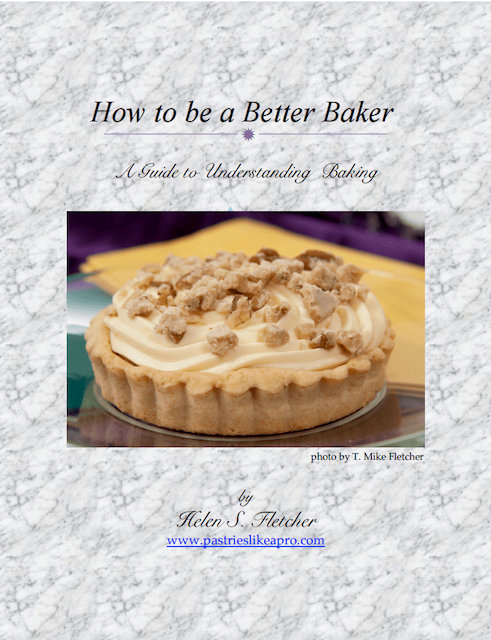

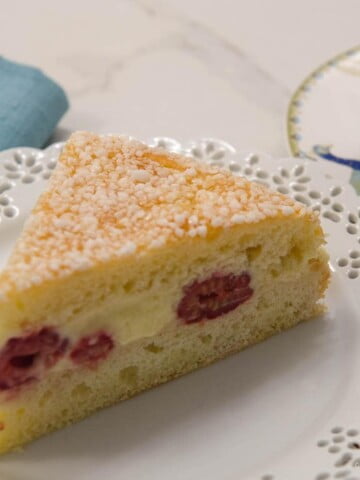
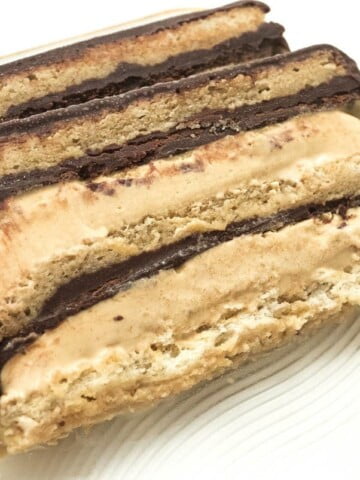
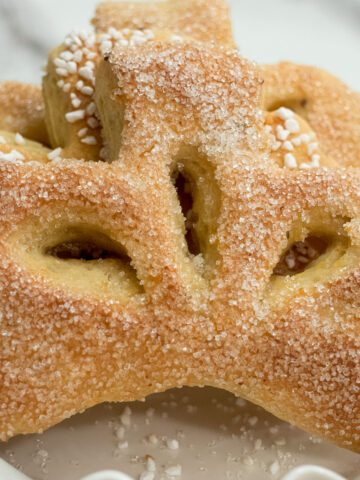
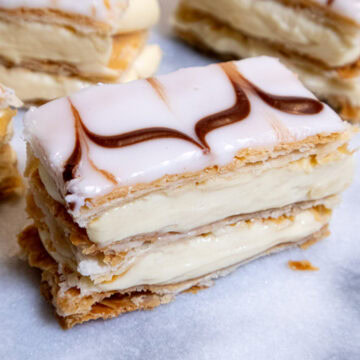

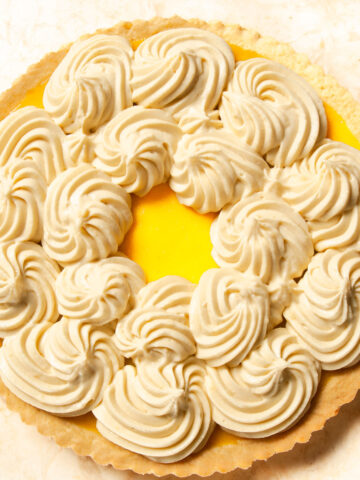
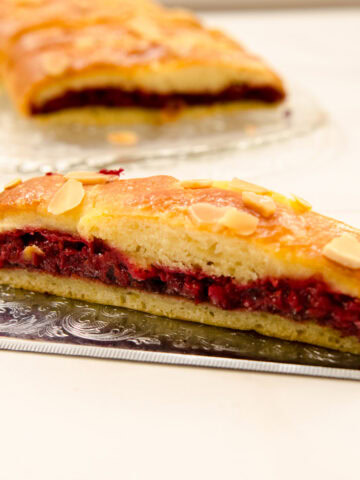
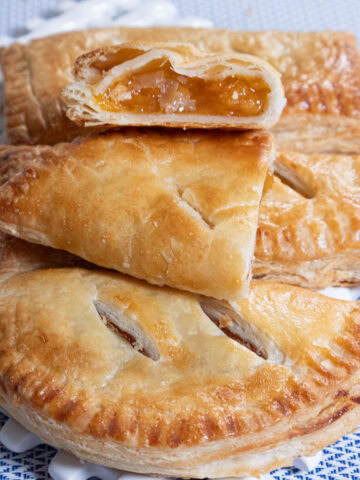
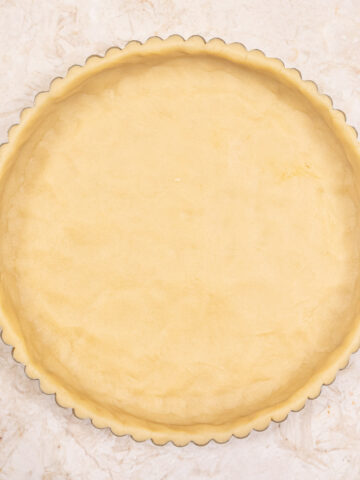
Hilda Willman says
Oh, Helen, the Napoleons at a long-ago bakery on Demun were the delight of my preteen years! And now you have revealed the secret to making this most treasured treat. I will make it and revel in memories. Happy Easter, dear friend!
Helen S Fletcher says
Hi Hilda - When the boys were in grade school while I was figuring out what I wanted to do with my life, I used to go to the Swiss Confisserie on Brentwood. It had so many classic French and Swiss pastries. I would go and always have the Napolean. It was so special for me and such a treat. I wish they were still around but alsas, they call it progress. Happy Easter to you also and it means a lot that we have been friends so long.
Inger says
Love that you posted this right after the pastry cream--all the building blocks! I even have some Dufour in my freezer!
Helen S Fletcher says
Hi Inger - that was the plan which is why I ran the Mille-Feuille just days afterwards. And aren't you lucky having Dufour tucked away! Sounds like you're all ready to go.